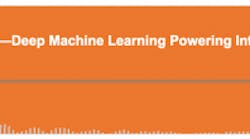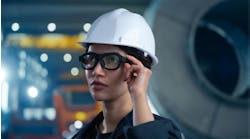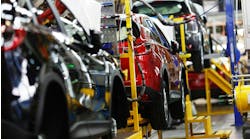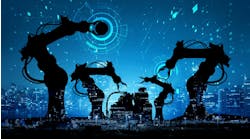Remaking Industry Podcast: Beyond mere AI with SICK's Divya Prakash
Click this graphic to listen to the podcast.
Chris: Welcome to the Smart Industry podcast, "Remaking Industry," where we dive deep into the tools, techniques, and technologies that are accelerating digital transformation. Thank you for joining us on the podcast today. My name is Chris McNamara, editor-in-chief with Smart Industry.
Today, we are talking about moving beyond mere artificial intelligence. We're looking at deep machine learning and how that's powering truly intelligent systems. Joining us today is Divya Prakash. He is director of business consulting for Industry 4.0 at SICK Sensor Intelligence. Divya, hello. How are you?
Divya: Glad to join you today.
Chris: Thank you for joining us. I'm excited about this—artificial intelligence, obviously, is a hot topic. It has been for a long time now. It continues to evolve like a lot of these tools and techniques that are central to all things Industry 4.0. So, it's always good to get updates about that from people who are leading the charge there.
Before we get into the meat of the presentation here, let's get to know you a little bit. What is a hobby that is a passion of yours, outside of work, Divya? What do you do in your free time?
Divya: Well, most of my free time is music and reading. But there's one hobby that I pursued a lot was, I like flying. But I don't have my flying licenses. So I am a virtual flyer. I fly flight simulators. That's pretty much what I do in my spare time.
Chris: Very cool. It kind of touches on artificial intelligence a little bit?
Divya: Yeah, yeah. It's artificially flying.
Chris: Well, let's talk that. Let's talk artificial intelligence tools and techniques. Are they changing as their use becoming more widespread, more common, and more mature? How are those tools and techniques evolving?
Divya: Well, artificial intelligence is a way to describe any system that can perform similar tasks that previously required human intelligence. So, that is, at a high level, what artificial intelligence really is broadly defined. Almost all AI systems today are created with machine learning, which uses large amounts of data to create and validate decision logics. This is called a model.
I mean, pretty much when you do AI, you need a model. The AI system feeds input data into that model, and then the model outputs human-like predictions of classifications. Of course, nobody can replicate a human brain, but we try to get as close to as possible. Essentially, machine learning is the underlying technology that powers intelligence systems.
Now, your question about tools and techniques, artificial intelligence tools and techniques are rapidly changing to be implemented across a wide range of applications. It has been applied across multiple industries. So, learning some applications in other industries are also now being applied within the industrial sector as well.
Machine learning has been around for decades, but it has been dependent on vast amounts of quality data and required significant effort, and specialized skills to train the models. So, that's not widely adopted in the industry. But with the new tools that have entered the marketplace, making the application of ML, machine learning much easier, they can filter. These tools can filter through large amounts of good and bad data points, and improve the quality of the data collected.
It is essential, because really, to build the model, you need good quality data. So, likewise, inclusion of cloud-based tools, leveraging data lakes are becoming increasingly popular. They offer more flexibility and agility, which enables companies to manage data types, all kinds of data types, structure or unstructured, from a wide variety of sources.
Chris: So, it's interesting, as obviously, as things become easier to use, they become more mainstream. They become more widely adopted, and then that fuels even further exploration and new iterations of their applications. Interesting stuff. So, it's becoming more mainstream. How is that altering industrial strategies? What is that empowering decision-makers to do better or easier or faster or smarter?
Divya: Good question. I mean, machine learning can be used for more than AI. A lot of people think it's just AI, but right now, most of the machine learning is AI-related, because this technology is evolving. So, it is being applied across the whole supply chain to bring about greater efficiency through sophisticated demand planning and forecasting models. So, you see that is being used today, especially today with the supply chain issues that we're seeing in the industry.
It is helping businesses make more informed and faster decisions enabled by data, and advanced, smarter analytics. So, you're not just going by gut feel. Now you have data that you can apply and model it, and then you can make decision based on that.
Chris: Right.
Divya: So, machine learning is also being used to analyze and enrich a range of existing products and processes. It's not just on the application side. It's even for product development, process improvement, improving overall product quality, and enhancing features and functionality, based on deeper experiences of customer. I mean, it has wide-ranging applications.
So, it is becoming more common to see these approaches moving into larger strategies, as companies strive to stay competitive, driving efficiency, and lowering the cost of manufacturing, you'll see this adoption.
Chris: Give me an example of a very common process optimization, courtesy of machine learning. What is something that you most often see as kind of a quick win or low-hanging fruit? Improved efficiency, less downtime, greater forecasting, predictive and prescriptive capabilities, what?
Divya: With this fourth industrial revolution, Industry, 4.0, as we call it, we are witnessing the trend of migrating into the cloud infrastructure. A number of solutions that have been proving themselves successful in the early application, the stuff we did on the plant floor, on the shop floor, and using systems, now we're seeing a lot of gradual migration of those, using the newer fourth industrial-technological changes that are coming and moving into the cloud.
This allows for additional computational resources, as well as scalability. So, leveraging edge solutions, collecting data, digitization, digitizing the data to provide cloud connectivity and advanced analysis, are some solutions we increasingly encounter. And that is what we are actively promoting as well, as one of the solutions moving forward.
These are complemented using smart sensors, and that's where our SICK Sensor Intelligence comes in. These smart sensors go beyond just sensing. They provide a plethora of contextual information, what is being made, what skew are you making, what product you're making, what shift it is, when, what time was it, and then all the other stuff, and the diagnostics that are coming, so making it a lot much better moving forward.
Chris: Interesting, yeah. My next question for you is what's an emerging tool that most excites you? I think we just touched on it there with some of these super smart sensors that are enabling this, quicker insights and more accurate insights. Anything else in terms of the tools at play in this capacity?
Divya: I mean, there are a number of new tools and they're all exciting and good. A lot of advancements going on in this. We have, our R&D department has been very busy advancing our sensors and adding a lot more new tools to get a better visualization of what's going on. So, there are a number of new tools on various platforms that have me excited.
But the most important thing that personally, for me, is deep learning. It's a class of machine-learning algorithms that is essentially a neural network, with three or more layers. Now, these neural networks attempt to simulate the behavior of the human brain as closely as possible, as I said earlier. You can never really duplicate the human brain. It's really very complicated.
Chris: Right.
Divya: Enabling them to learn from large amounts of data. So, we utilize this principle in our product. We have an algorithm called SICK Studio, which provides users with all the tools needed to train their models. The best part is, no additional hardware or software is required. It's browser-based. You can do it in the cloud. Our optimized neural networks allow for quicker success with training, even for users without profound machine-learning expertise.
The models then run on our SICK devices, our cameras, and all the other different plethora of devices that we have without the need for neural network access. So, you don't even have to be connected to a cloud or to anything. Once the model has been built, it has been downloaded into the sensors. Now, they make the decisions much faster, speedier, because it's happening right as close to the process as possible, and much more reliable.
Chris: Excellent. Divya, how long have you been consulting clients?
Divya: Oh, I've been in the industry for over 30 years, consulting for almost 25, 30 years.
Chris: So, you're the person to talk to. How is consulting changing? It's basically about consulting clients about digitally transforming their industrial operations. I assume you have to be less of an educator these days, as opposed to 10 years ago. People better understand these concepts and these approaches, and these tools. So, how is consulting businesses changing? What does consultation entail in the modern era, going through the lifecycle of products? And what do you see in terms of the near future of kind of leading clients down this road?
Divya: Yes. I mean, I mentioned earlier industry 4.0, the fourth industrial revolution. So, I've seen that in my lifetime. So earlier, we were concentrating on the third industrial revolution was a lot about automation, right?
Chris: Yes.
Divya: We spent a lot of time on automation. So, most of the consulting was, how do I automate? How do I run it consistently the same way every time? So, automation was a big focus. Then we moved into digitalization where we made everything data digitally available for us. And now what we are seeing is...what we are going through is called digital transformation.
Now we have all this digital data. How do I take this digital data as something...you know, raw data, there's no shortage of now. Every sensor, everything provides you raw data. So, how do I take that raw data, put some contextual information on top of it, and make it more actionable data? So, this is what we refer to as digital transformation. And you'll see that it's happening all around us, right? It's happening in everything, all across in our lives as well, the way we watch movies, the way we listen to music, everything has been digitally transformed.
Industry is no different. So, digital transformation is what is happening in the industry sector as well. And what we have realized, in our experience, in my experiences moving forward, it's not a straightforward path. When you start, when you decide on it, you get on it, it's a journey. Digital transformation is a journey that requires more than just great technology.
Now, it also means ensuring that the organization is aligned to the right business goals. You don't want to do automation or digital transformation just because that's the latest buzzword. You want to do it to try some of your business goals that you have. So, identifying and meeting those business goals, sometimes necessitates broad changes in the processes, management and culture of a company.
So, digital transformation requires all three of those: process, management and cultural changes. So, in a successful digital transformation journey, which is what we help as we consult, organizations leverage consultants, and internal resources, to create cross-functional teams that are built to address specific business problems. And you'll keep hearing me, I'm stressing on business problems. Because really, you want to do something to solve what your operational challenges are, right?
Chris: Of course.
Divya: So, this requires including both technical and domain experts within these teams. A lot of the domain technical expertise, the companies may not have. So, definitely consultants...as a consultant, we bring the technical expertise. But there's a lot of domain expertise within the operational staff that exists, and we involve them in the teams as well.
So, while the technical experts will take on the brunt of the model creation, most companies do not have all the expertise in-house and will continue to leverage consultants. So, they need the field knowledge of the domain experts to define the precise business challenges, and identify the data that's most important to finding a solution, and that realizes the truly intelligent system.
So, when we do the consulting, we really consult. We are not an outsider who just comes in and tells you how to do things. It is a collaborative effort. It's a journey where it involves, because nobody knows the plan better than their own staff, the operating staff. So, collaborate with them, understand the business challenge, understand what the KPIs are, and then work together to come up with a solution. And then we can guide them on the technology side as well and also our experience and domain expertise after having implemented solutions across multiple industries and multiple platforms to guide them on this journey.
Chris: Right. With most successful projects I hear about, it's that it's not doing digital for the sake of doing digital, but doing it aligned very closely with the larger business goals to achieve outcomes that are capable in the modern era. You talked about how each journey is unique and each company's unique, obviously, but other trends across industries, kind of larger verticals that inform some of these approaches.
Do process industries kind of have their own similar challenges and opportunities, as opposed to discrete industries, or utilities, things like that, or is it truly each case is completely unique?
Divya: Well, I mean, if you look at it, the methodology of consulting is similar across all the...most of the applications or industries that we work with, right. It is the process of identifying what the business challenges are, prioritizing the challenges based on the impacts on business, and then setting a roadmap to go forward to implement solutions delivery.
Now, the tenets are the same across all industries, but the types of challenges are different. So, if you go into retail industry, it will be different. If you go into a batch manufacturing, it will be different. If you go into automotive, it will be a little different. So the challenges are maybe different, but the process, the methodology of...as we go forward implementing it, is very much the same.
The one mistake most of the organizations often make when they start on this digital transformation journey is deploying a technical team in a silo. A lot of times people lead with technology, and that is something that I have seen is technology is a way to solve, but it's not the ultimate solution. The solution is to find out what is your business challenge that you're trying to solve? Solve the real business problem, right.
So, with no specific business problem to solve, it depends...it really becomes very difficult for executives to find it...to demonstrate the value of a digital transformation to the business executive counterparts. So, it is always important, and we get stuck in this what we call proof of concept. Everybody starts on a proof of concept, and nothing moves forward because you did a technical proof of concept to show technically, yeah, you can do it, but you did not show a business value of why you did it, so that you can now replicate it or expand it because you see a business value by solving this problem.
Chris: Well that makes sense. Last question for you, let's talk robots. How do robots and cobots come into play in these discussions? And what's your personal take? Are you encouraged by the rate of adoption? Or did you think it would be further along with robot adoption in this space? How do those come into play here?
Divya: Robots have been a part of our industry for many, many years, and robots will continue, and they play a very critical part, because they perform repetitive tasks, especially in areas where human safety is at risk. We are seeing now robots, and especially with some of our SICK sensors, we have given vision to the robots and our robots can see now. They can act.
So, yeah, I mean, and plus, they are good workers. They are very accurate. They reduce the amount of time you needed to do some work, and they really don't have much wastage. I mean, they use things very efficiently. So, I mean, robots will keep playing a big role, as they have been in the industry.
But what we see now is, as I mentioned earlier, robots with vision, so now they can see. They can pick things up. They can do stuff. And the best part that I'm seeing now is now the robots are no longer stationary. They used to be stationary, you know, just in one spot. Now, you're looking at autonomous mobile robots, robots that are moving around, picking things up, dropping at a different place.
So, I see robots playing a lot more role, especially in the digital transformation, moving forward, where they can work a lot of stuff autonomously, with very little human intervention, but doing it safely. And especially in that current trend that is in the market space, of the current labor shortage that we are seeing, we'll see a lot more of robots being adopted, or even cobots, as you mentioned earlier, working along with the operators to help them do the work much more efficiently. And yeah, so definitely robots are a very critical part of our digital journey as we're moving forward.
Chris: Yeah, it's very exciting. And when you see the ease of use of robots, that's fueling a lot of the adoption too there. They're so much simpler now to program and to shift from one task to another, and things like that. It's really mind-blowing.
Divya: Yeah, you bring up a good point. It's not just the physical ability of the robots, but even the way we can program them. It is all is getting easier and much more efficient to do that. So, yeah, they will be a very integral part moving forward.
Chris: Interesting. It's exciting to think about. Divya Prakash, with SICK Sensor Intelligence, thank you for joining us today on the "Remaking Industry" podcast.
Divya: Thank you. Thank you, Chris. It's my pleasure.
Chris: And to our listeners, as always, we encourage you to go out and make it a smart day.




